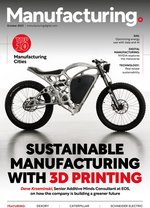Schneider Electric’s IoT advances real estate sustainability

IoT, AI and other machine learning technologies are helping to address some of the greatest challenges and opportunities in today’s commercial real estate industry. To provide comfortable, healthy buildings and achieve net zero, there is some complexity on the automation and optimisation side. But today’s IoT systems are much more intelligent and the knowledge needed to operate them and to oversee multiple systems is far less burdensome.
The Internet of Things constitutes the use of sensors, software and other physical information-collecting technologies in businesses. It is pervasive in the buildings industry and allows manufacturers to do more ‘light retrofits,’ which addresses a large portion of today’s real estate market and the increased demand to reduce energy and increase automation.
“By having IoT sensors and devices as part of our building systems, we can now connect straight to the Internet via wireless connection,” says Andre Marino, SVP, Digital Buildings Global LOB at Schneider Electric. “This means customers can digitise and augment their current systems or bypass older systems and go straight to the cloud, avoiding the need to replace a lot of existing infrastructure. This is a key component of retrofitting buildings, as 50% of today’s buildings will be in operation in 2050, as well as for small and mid-size buildings that need faster and simpler installation with less complexity.”
It's also applicable for large and new buildings where IoT helps provide more processing power, flexibility and access to more valuable data to help reduce energy use and increase decarbonisation. There’s a lot that Schneider Electric can accomplish today that was not possible some years ago.
“In comparison, in traditional manufacturing, there is a long and complex supply chain, including product development, processing, transportation and point of sale to the consumer. However, the commonality to real estate is about flexibility: being able to leverage a lot of data with cloud-based systems; sometimes bypassing or connecting with current installations in one building or an enterprise of buildings.”
Here, Marino tells us more.
IoT in the fourth electrical revolution
As the Sr. Vice President of Digital Buildings at Schneider Electric’s global Digital Energy Division, Marino’s role is to understand market needs and share the vision for the Digital Buildings line of business. He’s also responsible for ensuring that the team allocates the right people and resources to execute and deliver on those needs and vision.
“On behalf of our division, my mission for Digital Buildings is to deliver comprehensive building solutions that are good for people as well as the planet,” Marino explains. “This means we must ensure that all types of buildings are not only comfortable and healthy for people, but also net-zero carbon for the environment. It means providing solutions that help create Buildings of the Future: those that are Sustainable, Resilient, Efficient and People-centric.”
Before joining Schneider Electric’s Digital Energy Division, Marino worked in industrial automation, where he managed national and global operations, overseeing project services, very parallel to what Schneider Electric does in the real estate space.
“In those roles, I gained experience in navigating the industrial transformation, which has prepared me well for the 4th electrical revolution we are currently facing in the buildings segment.”
Marino believes that the convergence of electrification and digitalisation - known as Electricity 4.0 - is the fastest route to a net-zero carbon world.
“However, there are both differences and similarities. The markets are organised differently, but there is a common layer of automation and digital transformation, and a concern for climate change on both sides of the equations. Electricity enables green energy - it is the most efficient energy and the best vector for decarbonisation.”
Digitalisation allows Schneider Electric to make energy more visible, drives efficiency and helps eliminate energy waste.
IoT devices are making commercial real estate more sustainable
IoT and automation are helping integrate more systems in and around the building that includes not only HVAC, power and lighting, but also workplace services, EV charging stations, microgrids and other distributed energy resources (DERs). So while these systems and the data we can capture from them are much more complex, IoT devices and AI are helping us to gather and investigate vast quantities of previously inaccessible and unstructured data. These resources make systems easier to connect, manage, automate and provide actionable insights to ensure the buildings and their systems perform optimally and efficiently.
“Digital and IoT building technologies, for facility management as well as for tenants / occupants, help draw and retain younger skilled workers in highly competitive talent markets,” explains Marino.
The built environment contributes 37% of global greenhouse gas (GHG) emissions. Both old and new buildings must become more sustainable and achieve net-zero carbon. Marino sees that there is a lot of work to be done.
“One of the biggest sustainability implementation challenges is data collection, reporting and transparency. Capturing data and automating building systems – from multiple systems from both inside and outside of the building – helps reduce energy and increase decarbonization. Buildings are more connected and IoT facilitates the integration of once disparate systems, so they communicate and work together.
“For example, SpaceLogic™ Insight-Sensors can detect the number of occupants in a room and adjust HVAC and lighting accordingly, modifying energy use based on people in a room, and reducing energy use when spaces are unoccupied. The same sensors can open or close blinds in an office to help keep them cooler, warmer or brighter to reduce energy consumed.”
Paradoxically, while owners and managers of commercial real estate and other buildings strive for sustainability and efficient buildings, the demand for energy is going up.
“More electric vehicles require charging and require more energy which places additional strain on the grid. Having insight and understanding of these demand spikes can help real estate managers plan and operate more efficiently based on peak demand and pricing.”
Businesses can bridge action and sustainability utilising technology and by deploying a three-step path to net-zero buildings:
Strategise
Assess the sustainability status of the company and its buildings and develop a decarbonisation roadmap to implement technology, identify gaps and model retrofit scenarios for net-zero action
Digitise
Integrate the necessary digital solutions in buildings to track embodied carbon, measure energy usage and analyse energy/carbon efficiency
Decarbonise
Take actions like reducing the amount of carbon the business emits, electrifying business operations like transport, infrastructure and more, and installing the use of on-site renewables for direct, clean energy distribution to the building.
Many of the topics and trends discussed above are not new issues and were being addressed by Schneider Electric pre-COVID-19.
“I’d say the pandemic made them a greater reality and accelerated their priority industry-wide, such as the need for healthy, comfortable and flexible buildings, as well as for increased efficiency.”
Marino anticipates that the next 12 months at Schneider Electric will be very exciting as the company further deploys solutions and additional technologies to its customers and EcoXpert partners.
“They will help commercial real estate and building owners maximise their investments by addressing the needs of the planet and their tenants, while ensuring occupants are comfortable and productive.”
“We are leading in ESG and committed to become net-zero across our end-to-end value chain of stakeholders, suppliers and partners,” says Marino.
IoT, AI and other machine learning technologies, Schneider Electric will solve the challenges present in today’s commercial real estate industry - and beyond.
- Lenovo & Saudi Alat Building Green Manufacturing FacilitySustainability & ESG
- RIKEN & University of Tokyo Continue Fight Against PlasticSustainability & ESG
- Creating a 'Greener' Approach to Christmas Tree ProductionSustainability & ESG
- PUMA: Educating Gen Z on Green Fashion ManufacturingSustainability & ESG



